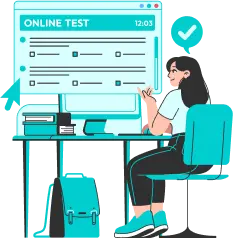
🎙️ About Respond to a Situation
This question type will present an audio or an audio-visual prompt describing an everyday situation. The student will need to listen to the prompt and respond accordingly in their own words. The response time includes 10 seconds (in PTE Academic / UKVI) & 20 seconds (in PTE Core) for preparation and 40 seconds for speaking. The audio recording will play automatically, and students will be assessed on their Speaking abilities.
For this question type you need to listen to and read a prompt describing an everyday situation.
- Task - Listen to and read a description of a situation. Then answer a question about it with an extended response.
- Skills assessed - Speaking
- Prompt length - Up to 60 words
- Time to answer - 40 seconds
You then need to provide a spoken response describing what you would say in the situation. You will have 10 seconds (in PTE Academic / UKVI) & 20 seconds (in PTE Core) to think about your response, and then 40 seconds to speak. The audio recording will play automatically. After the audio finishes you will have 10 seconds (in PTE Academic / UKVI) & 20 seconds (in PTE Core) to prepare. The recording status box displays a countdown until the microphone opens. You will hear a short tone. After the tone, start speaking immediately. Do not start speaking before the microphone opens because your voice will not be recorded.
You should speak clearly. There is no need to rush. Finish speaking before the progress bar reaches the end. The word “Recording” will change to “Completed”. You can only listen to the audio recording once. You can only record your response once.
Note: While the audio is playing, you can take notes on the erasable noteboard provided.
💡 Test Tips:
You have 10 seconds (in PTE Academic / UKVI) & 20 seconds (in PTE Core) to prepare, so examine the prompt to decide what main points you will need to convey, and whether you will need to use a formal or informal register.
Make good use of the 40 seconds speaking time:
You only have 40 seconds to speak so make sure you are able to cover everything required by the prompt within the time allotted. Try to speak for the whole 40 seconds if you can. If you repeat ideas, correct yourself, or hesitate, you will use up valuable time and also lose score points. So, keep talking and ignore any mistakes that you make.
Read Also: Listening: Multiple Choice, Single Answer
📝 How this question is scored:
Your score is based on three factors:
🎯 Content (PTE Academic / UKVI): Content is scored based on how appropriately and thoroughly you address the prompt, covering all key points with relevant and natural responses.
🎯 Appropriacy (PTE Core): Is the language used in your response relevant to and appropriate to the situation in the prompt? Appropriacy is scored by assessing how relevant and appropriate the language you use is to the situation and to the person(s) you are addressing. You should deliver your response clearly and politely, with either a formal or informal register being used, depending on the situation.
🌊 Fluency: Does your response show a smooth, effortless and natural flow of speech? Oral fluency is scored by assessing if your rhythm, phrasing and stress are smooth. The best responses are spoken at a constant and natural rate of speech with appropriate phrasing. Hesitations, repetitions and false starts will negatively affect your score.
🗣️ Pronunciation: Does your response show you can produce speech sounds in a similar way to most regular English speakers? Pronunciation is scored by assessing if your speech is easily understandable to most regular English speakers. The best responses contain vowels and consonants pronounced in a fluent-like way, and stress words and phrases correctly. Your answer should also be immediately understandable to a regular English speaker.
PTE recognizes regional and national varieties of English pronunciation to the degree that they are understandable to most regular speakers of the language.
Note:
- Partial credit scoring applies. No credit is given for no response or an irrelevant response.
- Your reading and listening skills are only used to read the instructions and to read and listen to the prompt. However, the question only contributes towards the Speaking score.
Source: https://pearsonpte.com
💡 Tips By ALFA:
Take notes utilizing the erasable notepads. Some test-takers take notes quickly and at the time of reading, they fail to comprehend their handwriting!
Along these lines, take clear notes in understanding what you have written. To improve note-taking rate, you may utilize flowcharts, shortened forms, or alternate route strategies. Or practice until you get accustomed to your note taking.
Note down basic keywords from the talk. They can be Adjectives, Adverbs, Verbs, Proper Nouns, and other logical words.
You may take single word notes. But, it is better to note down pieces of words, which you can use to build a total sentence.
On the off chance that you pause for over 3 seconds, the mic will stop naturally. Anything you state after that won't be recorded.
Avoid using fillers like 'uhm' and 'aah'.
Use connectors like 'besides', 'also', 'moreover', 'furthermore', and so on can be used. Use what is easy and what comes naturally.
While you are composing, monitor the clock, so you know that you're on target.



